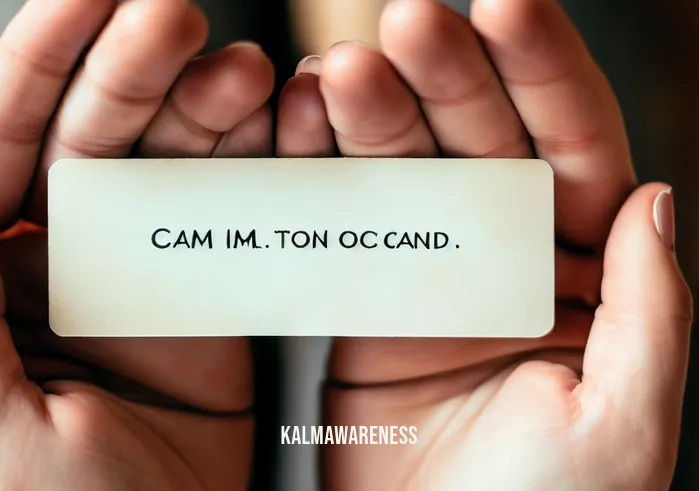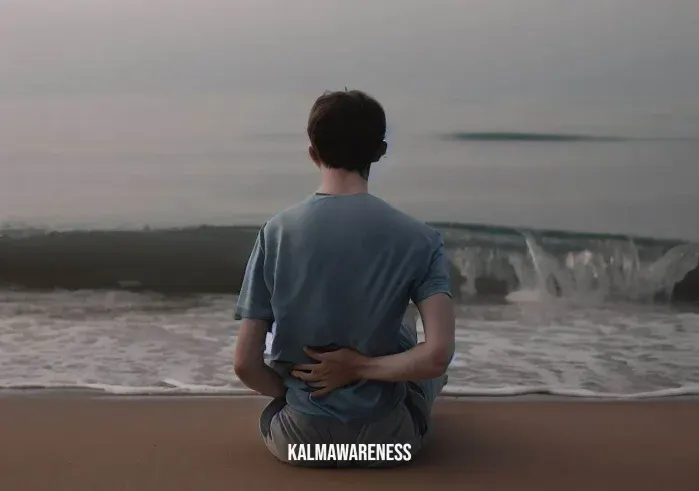Embracing Mindfulness Affirmation: A Journey to Inner Peace and Self-Improvement
Our thoughts, feelings, and actions shape our reality. The power of positive thinking, coupled with mindfulness techniques, has been shown to have profound impacts on mental health and overall well-being. Through mindfulness affirmation, we can achieve mental clarity, emotional balance, and foster personal growth. This article delves deep into the essence of mindfulness affirmation and its transformative power. It seeks to equip readers with insights and techniques that can serve as a stepping stone to improved mental health and a life of fulfillment.
What is Mindfulness Affirmation?
Mindfulness is the practice of staying present, being fully aware of the current moment without judgment. On the other hand, affirmations are positive statements that can help overcome negative thoughts. By combining these two powerful tools, we get mindfulness affirmation. This practice encourages one to be present and accept one’s current state while also envisioning a positive transformation.
For those unfamiliar with the concept, the Penn Mindfulness Class provides a comprehensive introduction, highlighting its significance in today’s fast-paced world.
The Multifaceted Benefits of Mindfulness Affirmation
Engaging in mindfulness affirmation can bring about numerous benefits:
- Enhanced Positive Thinking: Regularly practicing mindfulness helps in recognizing negative thought patterns. With affirmations, one can redirect these to more positive and constructive paths.
- Improved Mental Health: Mindfulness techniques have been scientifically proven to reduce symptoms of depression, anxiety, and stress. When we add the power of positive affirmations, this benefit multiplies.
- Deepened Self-awareness: By staying present and introspecting with affirmations, we get to know ourselves better—our fears, desires, strengths, and weaknesses.
- Boosted Self-esteem: Positive affirmations help in fostering self-worth. They act as reminders of our capabilities, leading to increased confidence.
For those looking for more in-depth practices, Mindful Martial Arts beautifully blends physical activity with mindfulness techniques, further enhancing the benefits.
Incorporating Mindfulness Affirmation in Daily Life
You don’t have to sit for hours in meditation to practice mindfulness affirmation. There are simple ways to incorporate it into your daily routine:
- Morning Rituals: Start your day with a short affirmation session. Look into the mirror and repeat your chosen affirmations. Believe in them. This sets a positive tone for the day.
- Mindful Breaks: Amidst the daily hustle, take short breaks. Maybe you could engage in micromeditating, focusing on your breathing and reciting affirmations in your mind.
- Evening Reflection: Before bed, reflect on your day. Recognize the moments you were present and those when you were not. Praise yourself for the former and affirm to do better in the latter.
For mothers juggling countless responsibilities, specially tailored techniques like Mindfulness for Moms can be immensely beneficial.
The Role of Guided Resources
While the journey of mindfulness is deeply personal, having the right resources can guide one through the process. Books, for instance, can be a treasure trove of knowledge. Titles recommended for young adults include Mindfulness Books for Teens, which introduce them to these life-changing practices at an impressionable age.
Applications like Mindful Harmony App are also great tools. They offer guided meditation sessions, affirmation playlists, and more, making the practice accessible at the tip of our fingers.
A Journey Ahead
Mindfulness affirmation is not just a practice but a lifestyle. It is a commitment to one’s well-being, a promise to embrace the present, and an affirmation to manifest positivity. This journey, while deeply personal, doesn’t have to be solitary. There are numerous communities, classes, and resources available that foster collective growth.
To explore how mindfulness techniques merge seamlessly with other activities, enhancing their benefits, delve into practices like Mindful Hiking.
As we proceed, in the next segment, we will explore the deeper layers of mindfulness affirmation, drawing from expert insights, real-life stories, and scientific studies. The path to inner peace and self-improvement beckons. Continue reading to unlock the transformative power of mindfulness.

The Layers of Mindfulness Affirmation: A Comprehensive Exploration
Unpacking the diverse dimensions of mindfulness affirmation, we encounter a myriad of tools, practices, and strategies that fortify this principle. From ancient teachings to modern techniques, the journey of mindfulness affirmation is rich with knowledge and insights that transcend cultures and generations. Let’s delve deeper into this fascinating subject and uncover the treasures that lie within.
Historical Roots and Global Acceptance
Mindfulness has its roots in ancient spiritual and cultural practices. Across the globe, from the calming chants of Tibetan monks to the serene routines in Rouse Yoga, these practices have aimed to keep the mind and soul at peace. With time, these ancient methods merged with the transformative power of affirmations, leading to the contemporary practice of mindfulness affirmation.
Building the Bridge: From Traditional to Modern
As society evolved, so did our methods to harness mindfulness:
- Traditional Meditation Sessions: Historically, meditation was a prolonged process, often stretching over hours.
- Guided Meditation: With advancements, structured programs like Meditation Made Simple have emerged, making meditation accessible.
- Digital Platforms: In today’s digital age, apps, podcasts, and online courses have democratized access to mindfulness techniques. Platforms like Mindful Harmony App lead the charge in this arena.
- Integrated Techniques: Modern approaches to mindfulness also integrate other holistic practices. A prime example is Gratitude Yoga in Princeton, where yoga and mindfulness techniques meld seamlessly.
Essential Components of Mindfulness Affirmation
To truly grasp the concept of mindfulness affirmation, it’s crucial to understand its components. Here’s a table outlining the foundational pillars:
| Component | Description | How to Practice |
|---|---|---|
| Presence | Being fully in the moment without distraction. | Practice deep breathing and focus on the breath. |
| Non-Judgment | Accepting experiences without labeling them as ‘good’ or ‘bad’. | Observe thoughts without attachment. |
| Affirmation Construction | Crafting positive, present-tense statements that resonate with you. | “I am capable” or “I embrace peace”. |
| Repetition | Consistently reciting affirmations to internalize their positive messages. | Daily affirmation practices or journaling. |
| Integration | Merging mindfulness and affirmations into daily routines. | Using apps or sessions like Keep it Simple Meditations. |
Mindfulness Affirmation in Specialized Areas
While the general principles of mindfulness affirmation apply universally, there are specialized areas where its application takes a unique turn:
- Children and Teens: In the formative years, instilling mindfulness can shape a balanced, positive mindset. Resources like Mindfulness Books for Teens cater specifically to this age group.
- Workplace: Corporate environments, often characterized by stress, can greatly benefit from mindfulness affirmation. Sessions led by a Meditation Consultant can introduce these practices to professionals.
- Personal Growth: Individuals seeking holistic personal development can attend workshops or sessions like the Personal Growth Seminar, where mindfulness affirmation is a key component.
A Glimpse of What’s Ahead
Having delved deeper into the realm of mindfulness affirmation, we’ve seen its vast scope and potential. Yet, the journey doesn’t end here. In the next chapter, we will explore real-life stories of transformation, expert insights, and delve into the science backing these practices. Prepare to be inspired and enlightened as we continue unraveling the world of mindfulness affirmation.

Voices of Affirmation: Real-Life Stories of Transformation
The theory and practice of mindfulness affirmation, while profound, truly come alive in the tales of those who have walked this transformative path. Each story, replete with hope and metamorphosis, resonates deeply, shedding light on the real-world implications and potential of mindfulness affirmation.
The Power of Present Moments
Thich Nhat Hanh, a renowned Zen master, beautifully encapsulates the essence of mindfulness in his words:
“Life is available only in the present moment.”
This profound statement, highlighted in Life is Available Only in the Present Moment, serves as a reminder that the journey of mindfulness is all about grounding oneself in the present.
Sara’s Journey: From Chaos to Calm
Sara, a high-flying corporate executive, often felt overwhelmed by the rigors of her profession. Burnout and stress seemed inevitable. However, a chance encounter with Mindful Miracle opened her eyes to the world of mindfulness affirmation. She began integrating these practices into her daily routine, starting with simple affirmations like, “I am at peace” and “I handle challenges with grace.”
Months later, Sara reported a profound shift in her mental well-being. The incessant mental chatter had quieted, replaced by a serene confidence. She attributes her transformation primarily to the mindfulness affirmations she embraced.
Mindfulness in Motherhood: Maria’s Tale
Being a new mother, Maria often felt adrift in the tumultuous sea of responsibilities. Sleep deprivation and constant care demands took a toll on her mental health. But then, Maria stumbled upon Mindfulness for Moms. Equipped with tools tailored for mothers, she began her journey.
A quote that particularly resonated with her was:
“In the midst of chaos, there is also opportunity.” – Sun Tzu
Maria’s journey wasn’t devoid of challenges, but with mindfulness affirmation, she learned to view these challenges as growth opportunities. Today, she is not only a happier mother but also an inspiration for many.
From Struggle to Strength: Jack’s Transformation
Jack, a college student battling anxiety, discovered solace in the teachings of Jack Kornfield Meditation for Beginners. His daily routine started with grounding exercises followed by mindfulness affirmations tailored for his situation.
An affirmation he found impactful was:
“Every breath I take brings me peace and moves me forward.”
With consistent practice, Jack’s anxiety began to wane. The gloomy clouds of uncertainty were replaced by the bright sunshine of hope and confidence.
Lessons from These Stories
These real-life experiences underscore a few vital lessons:
- Consistency is Key: Regular practice magnifies the benefits of mindfulness affirmation.
- Tailored Approach: Affirmations resonate more when they’re aligned with one’s personal challenges or aspirations.
- Seek Guidance: Platforms like Mindful Skills can provide structure to one’s mindfulness journey, making it more impactful.
Forward into the Depths of Mindfulness Affirmation
While these stories provide a glimpse into the transformative potential of mindfulness affirmation, there’s so much more to explore. In the next chapter, we’ll delve into the science behind these practices. Discover how neuroscience and psychology validate what countless individuals, like Sara, Maria, and Jack, have experienced. Continue reading to unlock the scientific magic of mindfulness affirmation.

The Anatomy of Mindfulness Affirmation: Dissecting the Process
As we journey deeper into the realm of mindfulness affirmation, it’s essential to demystify the intricate details that constitute this transformative practice. A deeper understanding can elevate our personal experience, offering clarity and enhancing the benefits we derive. With structured breakdowns and insights, this chapter serves as an analytical guide, simplifying complexities.
Elements that Define Mindfulness Affirmation
Mindfulness affirmation, at its core, is woven from multiple threads. Let’s unravel these components:
Mindful Awareness: Being deeply attuned to one’s current state, emotions, and thoughts without judgment. This foundation, rooted in practices like those shared in Meditation Pleine Conscience, is the bedrock of mindfulness.
Positive Affirmation: Constructive, empowering statements that are crafted to challenge and control negative thoughts, replacing them with positive beliefs. These often draw from one’s aspirations or values.
Intentional Repetition: The consistent repetition of these affirmations, anchoring them deeply into our psyche. Mindfulness Intentions dives deeper into this aspect, illustrating the importance of setting purposeful, clear intentions.
Emotional Engagement: Engaging with the affirmations emotionally, believing in their truth and allowing them to resonate deeply.
Crafting Effective Affirmations: A Guided Process
When venturing into mindfulness affirmation, crafting your own affirmations can be incredibly powerful. Here’s a step-by-step guide:
- Identify Negative Beliefs: Recognize any self-limiting or harmful beliefs you hold.
- Flip the Script: Transform these negative statements into positive affirmations. For instance, “I am always anxious” can become “Every day, I grow more peaceful and centered.”
- Stay Present: Frame affirmations in the present tense. Instead of “I will be confident,” say “I am confident.”
- Keep it Personal: Your affirmations should resonate with you, reflecting your aspirations, desires, or challenges.
- Invoke Emotion: Infuse your affirmations with emotion. Feel the positivity, hope, or calm they aim to instill.
The Benefits: More than Meets the Eye
The outcomes of mindfulness affirmation extend beyond mere mental well-being:
- Physical Well-being: Stress reduction can lead to tangible physical benefits, such as lower blood pressure or improved sleep.
- Improved Relationships: Being present and positive can lead to enhanced interpersonal relationships, marked by understanding and empathy.
- Career Advancements: A clear mind can boost productivity and creativity, paving the way for professional growth.
- Personal Growth: With reduced negativity, individuals often report personal growth and a deeper understanding of themselves.
For those particularly interested in the intersection of mindfulness and physical well-being, the practices taught in Gratitude Meditation Sleep beautifully showcase this harmony.
Challenges and Overcoming Them
Like any journey, the path of mindfulness affirmation comes with its challenges:
- Doubt: Initial skepticism or doubt about the efficacy of affirmations.
- Consistency: Maintaining a regular practice, especially when life gets hectic.
- Overexpectation: Expecting immediate or monumental changes.
Overcoming these challenges often requires patience, guidance, perhaps through a Meditation Consultant, and belief in the process.
Gearing Up for a Grand Conclusion
As we’ve dissected the multifaceted world of mindfulness affirmation, it’s evident that its magic lies in the details. With just one chapter left, gear up for a culminating exploration, where we tie all the loose ends, drawing from every aspect we’ve discussed so far. Get ready to have all your questions answered and curiosities satisfied in our concluding segment.

Reflections on Mindfulness Affirmation: A Journey Remembered
As we come to the end of our enlightening exploration into the world of mindfulness affirmation, it’s a fitting moment to pause, breathe, and reflect. Like the ebb and flow of waves, our journey was filled with highs, insights, stories of hope, and moments of introspection. As we gather our concluding thoughts, let’s retrace the steps of this journey and look ahead with rejuvenated spirits.
The Essence Revisited
Throughout our expedition, one truth stood unwavering: The power of the present. Mindfulness affirmation, at its core, is the harmonious marriage of being fully present and bolstering that presence with positive affirmations. The words of Thich Nhat Hanh, “Life is available only in the present moment,” as explored in Life is Available Only in the Present Moment, encapsulate this essence beautifully.
The Impact: Beyond the Intangible
While the mental and emotional transformations ignited by mindfulness affirmation are profound, the ripples extend far beyond. From fostering physical well-being to enriching interpersonal relationships and even bolstering career trajectories, the impact is holistic and far-reaching.
The Way Forward
With the knowledge and insights gained, the onus now lies on application:
- Daily Practices: Carve out moments each day to practice mindfulness affirmation. Be it during a morning routine, a mid-day break, or as nighttime reflections.
- Continuous Learning: The field of mindfulness is vast. Platforms like Mindful Harmony App offer a plethora of resources for continuous growth.
- Building a Community: Share your journey with others. Engage in group sessions or workshops like the Personal Growth Seminar to foster collective growth.
A Call to Continued Exploration
Our voyage into the world of mindfulness affirmation might be drawing to a close, but the journey of learning never truly ends. Delve deeper, explore more articles, stories, and resources available in our magazine. For those particularly intrigued by the blend of mindfulness and physical activity, our feature on Mindful Hiking is a must-read.
A Heartfelt Thank You
To our cherished readers who embarked on this journey with us, a heartfelt thank you. Your curiosity, engagement, and quest for knowledge inspire us to delve deeper and present insights that resonate. Rest assured, our commitment to bringing enlightening content remains unwavering. Here’s to many more journeys of discovery, growth, and transformation.
As we sign off, always remember: The present is a gift, and with mindfulness affirmation, you possess the power to unwrap its countless treasures. Until our next exploration, stay present, stay positive, and stay inspired.





